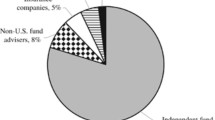Abstract
Recent market developments, such as on-line trading of Treasury securities and the reduction of the minimum Treasury bill denomination to $1,000, facilitate creation of a viable alternative to U.S. Treasury money funds for investors. Comparison of a direct investment in Treasury bills to U.S. Treasury money funds shows that money fund intermediary services such as check writing, telephone exchange privileges, payroll and automatic transfers, retirement plans, and minimum initial and subsequent purchases are worth an estimated 43 basis points per year, and investors pay an additional 11 basis points for active portfolio management. An analysis of fund net cash flows shows evidence consistent with arbitrage activity between money funds and the direct investment in Treasury bills, especially for investors with few ties to the money fund manager.
Similar content being viewed by others
References
Campbell, T., and W. Kracaw. “Information Production, Market Signaling, and the Theory of Financial Intermediation.” Journal of Finance 35 (September 1980), 863–882.
Capon, N., G. Fitzsimons, and R. Prince. “An Individual Level Analysis of the Mutual Fund Investment Decision.” Journal of Financial Services Research 10 (March 1996), 59–82.
Christoffersen, S. “Why Do Money Fund Managers Voluntarily Waive Their Fees?” Journal of Finance 56 (June 2001), 1117–1140.
Christoffersen, S., and D. Musto. “Demand Curves and the Pricing of Money Management.” Review of Financial Studies 15 (2002) 1499–1524.
DeGennaro R., and D. Domian. “Market Efficiency and Money Market Fund Portfolio Managers: Beliefs Versus Reality.” Financial Review 31 (May, 1996), 453–474.
Domian, D., and W. Reichenstein. “Performance and Persistence in Money Market Fund Returns.” Financial Services Review 6, no. 3 (1998), 169–183.
Diamond, D. “Financial Intermediation and Delegated Monitoring.” Review of Economic Studies 51 (1984), 393–414.
Diamond, D., and P. Dybvig. “Bank Runs, Deposit Insurance, and Liquidity.” Journal of Political Economy 109 (1983), 287–327.
Domian, D. “Money Market Mutual Fund Maturity and Interest Rates.” Journal of Money, Credit and Banking 24 (November 1992), 519–527.
Farinella, J., and T. Koch. “Seasonal Patterns in Money Market Mutual Funds.” Review of Quantitative Finance and Accounting 14 (May 2000), 261–276.
Farrar, D., and R. Davis. “The Optimal Time to Impose Normal Operating Expenses on Newly Organized Money Market Mutual Funds: When Should You Cut the Tree?” Financial Analysts Journal (Sept./Oct. 1991), 80–84.
Ferri, M., and H. Oberhelman. “A Study of the Management of Money Market Mutual Funds: 1975–1980.” Financial Management 10 (Autumn 1981), 24–29.
Frye, M. “The Performance of Bank-Managed Mutual Funds.” Journal of Financial Research 24 (Fall 2001) 419–442.
Gorton, G., and G. Pennacchi. “Financial Intermediaries and Liquidity Creation.” Journal of Finance 45 (March 1990), 49–71.
Investment Company Institute, Mutual Fund Factbook, 2003, available online at http://ici.org.
Kashyap, A., R. Raghuram, and J. Stein. “Banks as Liquidity Providers: An Explanation for the Coexistence of Lending and Deposit-Taking.” Journal of Finance 57 (February 2002), 33–73.
Koppenhaver, G. D. “Circle Unbroken: Bank-Affiliated Money Market Mutual Funds.” Global Financial Crises: Implications for Banking and Regulation, Proceedings of the 35th Annual Conference on Bank Structure and Competition, Federal Reserve Bank of Chicago, May 1999, 430–447.
LaPlante, M. “Influences and Trends in Mutual Fund Expense Ratios.” Journal of Financial Research 24 (Spring 2001), 45–63.
Lyon, A. “Money Market Funds and Shareholder Dilution.” Journal of Finance 39 (September 1984) 1011–1020.
Myers, S., and R. Rajan. “The Paradox of Liquidity.” Quarterly Journal of Economics 113 (1998), 733–771.
Whiting, C. “Persistence in Regulatory Innovation: MMMFs and Financial Intermediaries.” Journal of Economic Behavior and Organization 23 (1994) 321–342.
Williamson, O. Markets and Hierarchies: Analysis and Antitrust Implications. New York: The Free Press, 1975.
Author information
Authors and Affiliations
Corresponding author
Rights and permissions
About this article
Cite this article
Koppenhaver, G.D., Sapp, T.R.A. Money Funds or Markets? Valuing Intermediary Services. J Finan Serv Res 27, 51–76 (2005). https://doi.org/10.1007/s10693-005-6412-5
Published:
Issue Date:
DOI: https://doi.org/10.1007/s10693-005-6412-5




